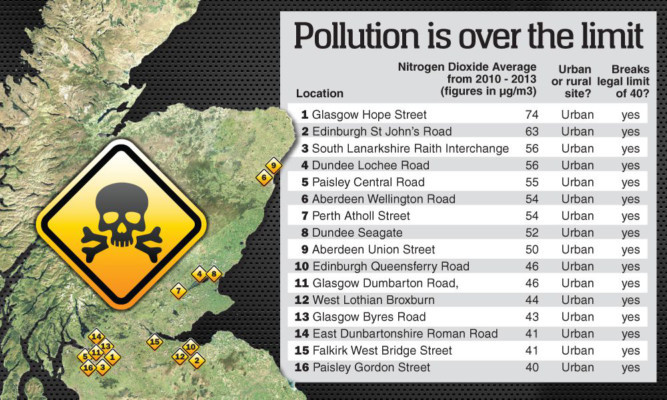
The map above reveals where a hidden killer linked to thousands of deaths stalks our streets.
It provides a breakdown of pollution hotspots linked to the high levels of the invisible gas pollutant nitrogen dioxide.
As many as 4000 people could be dying every year from exposure to nitrogen dioxide which is pumped out by traffic.
Sunday Post analysis has uncovered law-breaking levels of the pollutant across Scotland and the north of England over the past four years.
Now environmental campaigners are warning urgent action MUST be taken to avoid a pollution public health crisis which already claims 10 times the number of lives obesity does. Last night pollution expert Emilia Hanna, of Friends of the Earth, said: “We know that 2000 people in Scotland die early every year from exposure to pollution.
“However, that is only half the story, as that number does not include the impact of nitrogen dioxide. Once this toxic gas is taken into account, new research suggests the death toll from air pollution could be two times what experts previously thought.
“The Scottish Government must redouble its efforts to tackle this silent killer.”
Our probe looked at nitrogen dioxide levels over a four-year period from 2010 onwards when a legal limit set by the European Commission should have been met.
Health experts say exposure to the toxic gas leads to serious respiratory problems and is also linked to a higher risk of heart attack.
The samples analysed of Government certified data came from city centre pedestrian hot spots, urban greenbelt, and rural settings. The results make for shocking reading.
Monitors on Hope Street, Glasgow, recorded an average of 74 microgrammes per cubic metre, almost twice the European legal limit of 40, while analysis of data collected from St John’s road in Edinburgh came out with an alarming figure of 63.
Aberdeen’s Wellington road also had nitrogen dioxide levels breaking EU laws at an average of 54, while Dundee’s Lochee road clocked 56 and Perth’s Atholl street was slightly higher at 54.
In stark contrast, Bridge Street in Carlisle was well under the legal limit at just 29, with George Place in Peebles came in at just eight.
In Newcastle’s Jesmond Road and Deuchar Street the law was being broken with a recorded score of 43.
St Mary’s Place in Newcastle was just on the cusp with 40, while Sunderland scored a far-cleaner rate of 16 in Sunderland’s Silksworth Lane.
Air pollution campaigner Ms Hanna said the impact on the public’s health shouldn’t be underestimated.
She added: “High pollution increases the chances of having a heart attack, stroke, or asthma attack, while the toxic fumes affect children’s lung development and can cause long-term health problems.
“The analysis shows, since 2010, pollution levels have been breaking limits in streets all over the country, leading to ill-health and early death.
“The Scottish Government has so far failed to address air pollution with the seriousness it demands.
“Current budget spending plans shows they intend to spend 200 times as much money next year on building new roads as on tackling air pollution. Instead, it needs to get behind the Low Emission Strategy and champion a new approach to transport in Scotland by investing in cycle paths and bus improvements.”
Earlier this month, a House of Commons report slammed the UK Government for failing to tackle the issue of air pollution which across the whole of country is currently estimated to be responsible for 29,000 deaths a year. The Environmental Audit Committee also said new schools, care homes, and hospitals should be built as far away as possible from major roads because of the toxic gases emitted.
A detailed Scottish Government draft budget for 2015-16, however, allocates just £3.15m to improving air quality, compared with £694.8m for motorways and trunk road infrastructure.
Last month, the European Court of Justice ruled the UK was in breach of EU law and must create plans to tackle air pollution. It’s not expected Edinburgh, parts of north-east Scotland and central Scotland will be within the legal limit until 2020, with Glasgow taking a further five years. Failure to do so could result in massive fines for the Government.
Many fear the cultural step change needed to address soaring pollution rates is simply so vast it has actually become unmanageable.
A spokesman for leading environmental lawyers Client Earth said: “The European Court ruling was a big victory for the millions of people who want to live healthy lives in the UK’s towns and cities. It will force the UK and the Scottish Governments to finally take this issue seriously and come up with an urgent plan to rid our towns and cities of cancer-causing diesel fumes.”
The Scottish Government is expected to launch a new pollution-busting strategy in the coming weeks.
A spokeswoman insisted they were working closely with local authorities to improve air quality.
She said: “Although there has been excellent progress, we recognise that there is more to be done to deliver further benefits for human and environmental health where areas of poorer air quality remain.
“We also recognise air pollution disproportionately affects the health of the most vulnerable members of society.
“Our forthcoming Low Emission Strategy will set out the contribution that reduced air pollution can make to delivering sustainable economic growth and enhancing the quality of life for communities across Scotland, with a focus on progress in Scottish towns and cities over the coming years.”

Enjoy the convenience of having The Sunday Post delivered as a digital ePaper straight to your smartphone, tablet or computer.
Subscribe for only £5.49 a month and enjoy all the benefits of the printed paper as a digital replica.
Subscribe